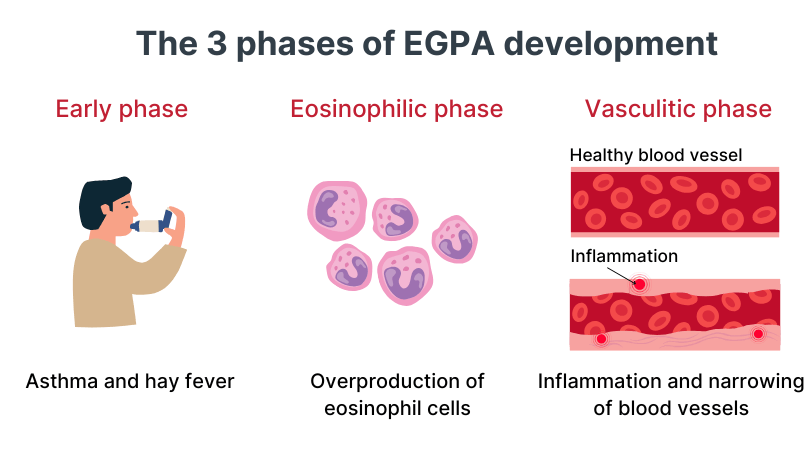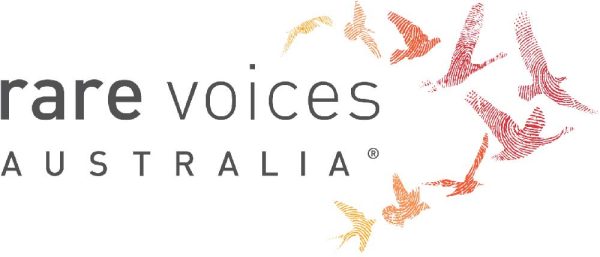Eosinophilic granulomatosis with polyangiitis (EGPA)
Quick Search
- Summary
- Synonyms and Classifications
- Symptoms
- Disability Impacts
- Cause and Inheritance
- Diagnosis
- Treatment
- Clinical Care Team
- Clinical Care Guidelines
- Emergency Management
- Research
- Rare Disease Organisation(s)
- Lived Experience
- Support Services and Resources
- Mental Health
- Other Information
- Useful Links for Healthcare Professionals
Summary
Eosinophilic granulomatosis with polyangiitis (EGPA) is characterised by chronic asthma and inflammation of small and medium blood vessels.1,2 EGPA typically develops in three stages with distinct features.
- The ‘early phase’ involves asthma and hay fever which can occur years before the onset of any other symptoms.
- The ‘eosinophilic phase’ begins when a type of white blood cell, called ‘eosinophils’, are overproduced. Eosinophils usually fight pathogens (bacteria and viruses) but in EGPA, they build up in the blood stream and organs where they cause damage. As they accumulate, they may form clusters called granulomas which promote inflammation.
- The ‘vasculitic phase’ begins when vasculitis (sometimes called angiitis) starts. Vasculitis is the inflammation and narrowing of blood vessels. In EGPA, vasculitis affects many small and medium blood vessels throughout the body and prevents adequate blood flow to nearby body parts.
The accumulation of eosinophils (eosinophilia) and vasculitis separately or together can cause serious tissue and organ damage. The affected body parts and associated complications differ between individuals depending upon where the vasculitis and inflammation occur. The three phases of EGPA development can occur at the same time, or years apart, and in any order.

Some individuals with EGPA have been found to have anti-myeloperoxidase (MPO)-anti neutrophil cytoplasmic antibodies (ANCA) in their blood. These auto-antibodies are not specific to EGPA but are present in a few different types of vasculitis conditions. The presence of these MPO-ANCA antibodies and how they may contribute to EGPA is still not well-understood.3-5
Synonyms and Classifications
Synonyms: EGPA, CSS, Churg-Strauss vasculitis, allergic granulomatosis, allergic granulomatous angiitis, allergic angiitis.3
Previously known as Churg-Strauss syndrome (CSS), it was renamed eosinophilic granulomatosis with polyangiitis (EGPA) in 2012.6
Universal rare disease classifications provide a common language for recording, reporting and monitoring diseases. Please visit the Rare Disease Classifications page for more information about these internationally recognised classifications.
Symptoms
Symptoms of EGPA vary widely between individuals and change as the disease progresses.1-4,6
Asthma is typically the first symptom of EGPA, sometimes occurring years before any other signs.3,5,6 It is usually severe and worsens over time (preexisting and progressive asthma). This may coincide with other allergy-like symptoms such as hay-fever (allergic rhinitis), painful sinuses or face (sinusitis) and runny or blocked nose. Small ball-like bumps can often be found inside the nose or sinus (nasal polyps) early in the disease. Some people also experience flu-like symptoms such as feeling generally unwell with aches, tiredness, fever, and swollen lymph nodes.
Symptoms typically progress to include signs of organ damage during the eosinophilic and vasculitic phases of EGPA.1-7 The symptoms and their severity depend upon which blood vessels and organs are affected. The symptoms of EGPA can be extremely broad and are not just limited to these characteristic symptoms listed below:
- abdominal pain, nausea, stomach cramps and/or vomiting (gastritis, enteritis, or colitis)
- skin rashes which may cause scarring
- nerve damage (neuropathy) including pain or burning, numbness or tingling, weakness or loss of feeling anywhere in the body
- kidney disease which may result in high blood pressure (renal hypertension)
- pus, blood, small clumps of cells (polyps) or other unusual substances in the lungs (pulmonary infiltrates). The most common sign of this is pneumonia.
- chest pain and/or heart palpitations
There may also be complications associated with EGPA, including life-threatening respiratory issues, kidney failure, blood clots (thrombosis), aneurysms, permanent loss of feeling in hands or feet, stroke, and heart failure.1,2,5,7-9
Please speak to your medical team to learn more about the symptoms and complications of EGPA.
Disability Impacts
Rare diseases are often serious and progressive, exhibiting a high degree of symptom complexity, leading to significant disability. Majority of the estimated two million Australians living with a rare disease meet the Australian Government’s definition for disability (in accordance to the Australian Public Service Commission and Australian Bureau of Statistics), and many experience severe and permanent disability impacts. If you or someone you care for is experiencing disability-related impacts from a rare condition, please speak with a health or disability professional for advice. Information about relevant disability support can be found at the RARE Portal’s Disability Support Information page.
Cause and Inheritance
The cause of EGPA is not fully understood. It is thought that it may be caused by a combination of environmental factors (such as allergens and infections), an overactive immune system, and genetics.1,3,8
Diagnosis
EGPA may be diagnosed based on physical examination, extensive medical history, blood tests to check for high levels of eosinophils (a type of white blood cell) and MPO-ANCA antibodies, and imaging scans.4,5,8,9 Scans may include X-ray and computed tomography (CT) to detect for abnormal clumps of cells (polyps) in the sinuses and lungs.
More information about the blood tests can be found at
- Pathology Tests Explained: White Blood Cell Count
- Pathology Tests Explained: ANCA (Antineutrophil cytoplasmic antibodies)
Please speak to your medical team to learn more about the available diagnostic pathways for EGPA.
Treatment
There is currently no curative treatment for EGPA. Treatment is targeted at controlling eosinophil levels and inflammation, which may involve:2,5,8,10
- corticosteroid medication to reduce inflammation
- medication that suppresses the immune system (immunosuppressive drugs)
- biologic medications which inhibit certain inflammatory pathways in the body
As individuals with EGPA are at risk of life-threatening heart and kidney complications, it has been recommended that their heart and kidney health are regularly monitored to allow for early detection and interventions to manage such complications.1,2 It has also been recommended that individuals with asthma avoid smoking and second-hand smoke.10,11
There are also management strategies for treating the other complications associated with EGPA, such as chronic asthma, kidney disease, nerve damage and skin damage.5
Please speak to your medical team to learn more about the possible treatment or management options for your condition. Treatment will depend on an individual’s specific condition and symptoms. It is also important to stay connected to your medical team so that you can be made aware of any upcoming clinical trial opportunities.
Clinical Care Team
Healthcare professionals involved in the treatment of EGPA may include general practitioners (GP), paediatricians, immunologists, cardiologists, dermatologists, otolaryngologist, rheumatologist, pulmonologist.12,13 The need for different healthcare professionals may change over a person’s lifetime and extend beyond those listed here.
Clinical care for rare diseases often involves a multidisciplinary team of medical, care and support professionals. Please note that the information provided here is as a guide and that RVA does not necessarily monitor or endorse specific clinics or health experts.
For many rare diseases, palliative care services may be relevant and useful. Palliative care services are available for people (adults, children and their families) living with a life-limiting illness. Palliative care services provide assistance, support, resources and tools to help people manage their illness and the symptoms, ease pain, and improve comfort and quality of life. Palliative care is not only for end-of-life care. It can also help at any stage of illness from diagnosis onwards, and will look different for different people. For more information about palliative care and how it can help you, please visit:
Clinical Care Guidelines
We are not aware of any clinical care guidelines for EGPA in Australia. If you know of any relevant care guidelines, please let us know via the Contribute page.
The following guidance is available from international experts outside Australia; however, there may be information that is not relevant or applicable to the Australian context, and may not be up to date:
- Evidence-Based Guideline for the diagnosis and management of eosinophilic granulomatosis with polyangiitis was developed by a panel of European experts and published in 2023
- EULAR recommendations for the management of ANCA-associated vasculitis: 2022 update was developed by European Alliance of Associations for Rheumatology (EULAR) and published in 2022
- 2021 American College of Rheumatology/Vasculitis Foundation Guideline for the Management of Antineutrophil Cytoplasmic Antibody-Associated Vasculitis was developed and published in 2021 to provide evidence-based recommendations and expert guidance for the management of antineutrophil cytoplasmic antibody–associated vasculitis (AAV), including EGPA.
- 2022 American College of Rheumatology/European Alliance of Associations for Rheumatology Classification Criteria for Eosinophilic Granulomatosis with Polyangiitis was developed to help accurately classify EGPA for research purposes; please note that it was not developed for diagnostic purposes.
Emergency Management
Individuals living with rare diseases may have complex medical issues and disabilities, which are not always visible. It is often useful to refer to their medical history as well as personal information such as a medical card, doctor’s letter, or if available, a rare disease passport, for relevant information.
Research
ausEE Inc: Research provides information about research on eosinophilic diseases in Australia, including funding for medical research grants.
There are specific considerations around participating in rare disease research, including clinical trials. It is important to be mindful of issues such as data privacy, research ethics, consent and differences in research regulations between Australia and other countries.
If you are interested in finding clinical trials for your condition, please visit the following websites; however, there may not be any clinical trials available:
It is best to discuss your interest in any clinical trials with your medical team to determine suitability and eligibility.
Rare Disease Organisation(s)
Australian Organisations:
ausEE Inc.
Website: https://ausee.org
ausEE Inc. is Australia’s peak national support and patient advocacy organisation representing Australians living with an eosinophilic disease, including EGPA and eosinophilic gastrointestinal diseases (EGIDs).
Australia and New Zealand Vasculitis Society (ANZVASC)
Website: https://www.anzvasculitis.org/
The ANZVASC is a collaborative organisation of physicians, scientists, and communities that focuses on research, education, and clinical practices in vasculitis.
Please note that RVA does not monitor or endorse each group/organisation’s operational governance and activities. When engaging with a group, please consider the information on the RARE Portal’s Finding Helpful Peer and Community Supports page.
Lived Experience
EGPA varies between individuals, and each person’s experience is unique.
If you would like to share your personal story with RVA, please visit the Rare Voices Australia: Share Your Story page. RVA will consider your story for publishing on our website and inclusion on the RARE Portal.
Support Services and Resources
ausEE Inc. offers support programs, including for peer support.
For information on available government and social services that provide support for individuals with a rare disease, please visit the National and State Services pages.
Mental Health
People living with a rare disease, including families and carers, often face unique challenges such as diagnostic delays, misdiagnoses, limited treatment options, and limited access to rare disease specialists and support. These challenges may impact people’s emotional wellbeing and quality of life. Many people find it helpful to seek mental health and wellbeing support to cope with ongoing stress and uncertainty. Connecting with people who have shared experiences through a support group may also be helpful. Information about relevant mental health and wellbeing support can be found at:
- Mental Health and Wellbeing Support for Australians Living with a Rare Disease
- The National and State Services pages underneath the ‘Mental Health’ sections listed
Other Information
Further information on EGPA and other vasculitis conditions, can be found at:
- healthdirect: Vasculitis
- AnzVasculitis: Vasculitis Types
- Genetic and Rare Diseases (GARD) Information Center: Eosinophilic granulomatosis with polyangiitis
- National Organization for Rare Disorders (NORD): Eosinophilic granulomatosis with polyangiitis
- Vasculitis Foundation’s Eosinophilic Granulomatosis with Polyangiitis: A Patient’s Guide to Resources and Hope – a patient booklet developed by the Vasculitis foundation and American Partner for Eosinophilic Disorders; please note that some of the information may not be relevant to the Australian context
Useful Links for Healthcare Professionals
References
- Chakraborty RK, Aeddula NR. Eosinophilic Granulomatosis With Polyangiitis (Churg-Strauss Syndrome). 2024. Updated 23 March 2023. In: StatPearls [internet]. Treasure Island (FL): StatPearls Publishing; 2024 January. Accessed 15 August 2024. https://www.ncbi.nlm.nih.gov/books/NBK537099/
- Orphanet. Eosinophilic granulomatosis with polyangiitis. Updated October 2020. Accessed 15 August 2024. https://www.orpha.net/en/disease/detail/183
- National Organization for Rare Diseases. Eosinophilic Granulomatosis with Polyangiitis. Published 1989-2024. Updated 20 June 2024. Accessed 19 August 2024. https://rarediseases.org/rare-diseases/churg-strauss-syndrome/
- Australia and New Zealand Vasculitis Society (ANZVASC). Vasculitis types. Accessed 5 August 2024. https://www.anzvasculitis.org/vasculitis-types/
- Emmi G, Bettiol A, Gelain E, et al. Evidence-Based Guideline for the diagnosis and management of eosinophilic granulomatosis with polyangiitis. Nature Reviews Rheumatology. 2023;19(6):378-93. https://doi.org/10.1038/s41584-023-00958-w
- Jennette JC, Falk RJ, Bacon PA,et al. 2012. Revised International Chapel Hill Consensus Conference Nomenclature of Vasculitides. Arthritis Rheum. 2013; 65(1): 1-11. https://doi.org/10.1002/art.37715
- American Lung Association. Learn About Eosinophilic Granulomatosis with Polyangiitis (EGPA). Updated 7 June 2024. Accessed 16 August 2024. https://www.lung.org/lung-health-diseases/lung-disease-lookup/egpa/about-epga
- American Partner for Eosininophilic Disorders, Vasculiits Foundation. Eosinophilic Granulomatosis with Polyangiitis: A Patient’s Guide to Resources and Hope. July 2024. 23p. https://www.vasculitisfoundation.org/wp-content/uploads/2024/07/egpa-patient-guide_FinalJuly24.pdf
- Vasculitis Foundation. About Eosinophilic Granulomatosis with Polyangiitis. Updated 5 February 2024. Accessed 13 August 2024. https://www.vasculitisfoundation.org/education/vasculitis-types/eosinophilic-granulomatosis-with-polyangiitis/
- American Lung Association. Symptoms and Diagnosis of EGPA. Updated 7 June 2024. Accessed 19 August 2024. https://www.lung.org/lung-health-diseases/lung-disease-lookup/egpa/symptoms-diagnosis
- American Lung Association. Treating and Managing EGPA: American Lung Association. Updated 7 June 2024. Accessed 19 August 2024. https://www.lung.org/lung-health-diseases/lung-disease-lookup/egpa/treating-and-managing
- Victoria State Government Department of Asthma and Smoking. Better Health Channel; 2024. Updated 22 September 2024. Accessed 2 September 2024. https://www.betterhealth.vic.gov.au/health/conditionsandtreatments/asthma-and-smoking
- Praveen Akuthota. What is Eosinophilic Granulomatosis with Polyangiitis? American Partner for Eosininophilic Disorders. Updated March 2020. Accessed 19 August 2024. https://apfed.org/about-ead/eosinophilic-granulomatosis-with-polyangiitis/
Contributors
This page has been developed by Rare Voices Australia (RVA)’s RARE Portal team.
If you are aware of any additional information that may benefit stakeholders with an interest in this page, or if you notice any broken links or inaccurate information, please let us know via the Contribute page.

